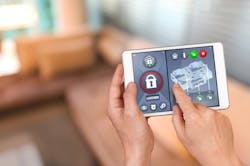This year’s International Consumer Electronics Show (CES) in Las Vegas is abuzz with a variety of new smart home gadgets that promise to make the lives of everyone a little bit better. From appliances and entertainment devices to thermostats, lights and even mattresses, just about everything within a household can now be connected to the Internet and monitored and/or controlled with a smartphone. However, in this Internet of Things landscape that we find ourselves in, it’s almost easy to forget that one of the main catalysts responsible for helping to drive this innovation in smart home technology has been security.
According to a recent study conducted by Harris Poll on behalf of real estate firm Coldwell Banker, nearly half (45 percent) of all Americans either currently own smart home technology or plan to invest in it in 2016. Sean Blankenship, chief marketing officer of Coldwell Banker, said that while smart entertainment devices have served as an entry point into the smart home market for most consumers, with 44 percent of survey respondents indicating they own such a product, the next most popular type of product that people said they had installed in their home is smart security at 31 percent, which he expects will only continue to climb.
“Smart security was one of the biggest drivers with early smart home adopters from the beginning,” said Blankenship. “Moving forward, smart security is only going to get larger and find its way into more people’s homes, especially because of the obvious benefit to consumers.”
When asked what needs to be in a home for it to be considered “smart,” the top responses in the study, which polled more than 4,000 people, were; locks and alarm systems (63 percent); temperature (e.g., thermostats and fans – 63 percent); lighting (e.g. light bulbs and lighting systems – 58 percent); and, safety (e.g. fire/carbon monoxide detectors and nightlights – 56 percent).
In addition, Blankenship said the survey revealed that 58 percent of Americans find smart security to be the “most appealing” pre-installed home technology.
“Buying and moving into a new home is stressful enough, so homebuyers are often relieved to settle into a home that is already equipped with this type of technology. Based on my experience, the first smart security product homeowners buy are smart wireless cameras,” added Blankenship. “Those selling their home are realizing the value of having smart technology pre-installed in their home as well. More than half of homeowners (54 percent) said they would purchase or install smart home products if they were selling their home and knew that doing so would make it sell faster. Of that group, 65 percent would pay $1,500 or more.”
George De Marco, ESX chairman and managing partner at DECO Ventures, said the security industry was “very instrumental” in helping to raise awareness about the home automation and control market, which subsequently morphed into the smart home industry following the proliferation of smartphones among consumers.
“Mobile apps allowed security companies and custom electronics companies to deliver products and services that were really engaging for customers. When that started happening, the security industry realized when you have that type of customer engagement then you’re going to be able to create more recurring revenue because you’re delivering products and services that customers want to use every day,” said De Marco.
Now that being able to support and integrate with other connected devices within the home has become the expectation of consumers, security companies – both hardware manufacturers and service providers – have to search for ways to differentiate their offerings. Therefore, De Marco said the industry has become heavily focused on user intuitiveness.
“When you can engage the customer with a product or service – whether it is the hardware or a service in the cloud – if the experience is practically seamless, simple and easy to use, that goes a long way in differentiating companies from each other,” he said. “The end-users are the ones that vote with their wallets and they will pick and choose who will be the winners and losers in the space and it usually comes down to ease of operation and ease of implementation.”
Aside from improving ease of use, Blankenship said the industry has also been able to make security hardware, such as cameras and alarm panels, more aesthetically pleasing to consumers.
“Like with any new technology, smart home security is constantly changing and improving. At the moment, the smart home industry as a whole is working to develop platforms that combine all smart home products, so they work seamlessly together in consumer’s home,” said Blankenship.
The increased interest among consumers in smart home technology has also given rise to a new product category which at one time would have been unthinkable and that is do-it-yourself security systems. While these types of solutions are still in their infancy, a number of start-ups and even established firms have introduced DIY products to the market which offer customers a wide-variety of monitoring options. Some provide traditional alarm monitoring from a third-party provider while others only offer customers the ability to monitor the systems themselves. Several companies even offer a hybrid or on-demand-type of monitoring solution for their customers.
In fact, earlier this week, Lowe’s announced that it has partnered with United Central Control to offer professional monitoring services to those who have purchased its Iris solution. Customers can choose to pay for professional monitoring on a month-to-month basis without having to enter into a long-term contract. These types of monitoring options are a paradigm shift for an industry that relies on RMR as its financial backbone.
“There are a lot of people looking at their traditional offerings and they’re saying, ‘I wonder is there another way of growing my company and pushing out the boundaries of where I operate?’ With DIY or self-installed offerings - if done right - you can expand wherever the demand is and you don’t have to roll a truck,” said De Marco.
Despite all of the buzz and excitement around the smart home, there is a real danger that people become fatigued with all of these features that while neat, don’t offer solutions to real world problems.
“If you’re buying a system that can control your home, how many times are you going to turn your lights on and off throughout a day? How many times are you really going to interact with your thermostat? If you start thinking in terms of a life-on-demand type of mentality where technology should be considered a better method… devices and their interactions should be able to create predicative or actionable outcomes,” said De Marco. “For example, let’s say you have an open window in your home. What if you’re security system not only creates a message that says, ‘Ok, there is a security concern here you have an open window,’ but it also lets you know the air conditioning is on? When you think in terms of those possibilities, it becomes pretty powerful.”


